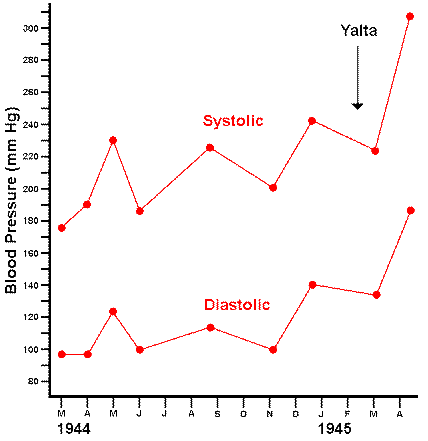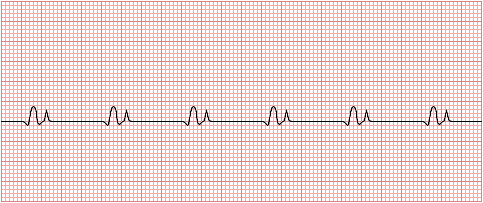Adapted from: N Engl J Med 1995; 332:1038-1039
On April 13, 1945, the world learned of the sudden and unexpected death of Franklin D. Roosevelt, 32nd president of the United States, who had died in Warm Springs, Georgia, the day before. No one suspected that he had a serious medical condition, and Admiral Ross McIntire, the president's personal physician, stated that the fatal cerebral hemorrhage "came out of the clear sky". The pertinent findings as recorded by the president's cardiologist, Dr. Bruenn, are shown below:

At the start of the above chart, in March 1944, FDR had left ventricular hypertrophy on an EKG and cardiomegaly on chest x-ray. A urinalysis showed mild proteinuria. Throughout 1944 he had dyspnea from congestive heart failure.
On the morning of April 12, 1945, FDR reported a "terrific" occipital headache while being sketched for a portrait. He lost consciousness immediately thereafter and Dr. Bruenn recorded a blood pressure of >300/190 mm Hg. FDR was pronounced dead at 3:35 p.m. The president's medical record kept in a safe at the U.S. Naval Hospital in Bethesda, Maryland disappeared after his death and was never found again.
8.1 What is the diagnosis?
It is unlikely that FDR had essential hypertension since this disorder usually does not first appear at the age of 54 (Roosevelt's age at re-election in 1936 and when he first became hypertensive) and proceed to malignant hypertension in only 10 years. FDR probably had renovascular disease. His major risk factor was smoking. He had a sedentary lifestyle since early adulthood, when a bout of poliomyelitis left him paraplegic. When FDR's body was embalmed, it was noted that his arteries were so narrowed that it was difficult to perfuse the body with embalming fluid..
In 1945 hypertension was not considered a disease and was still considered by most physicians as "essential" to force blood through sclerotic arteries to the body's organs. Moreover, no effective therapy was available. Thus, FDR's physicians may not have considered him to be in poor health or imminent danger, and Admiral MccIntire's assessment may not have been a political cover-up. Admiral McIntire (an ear, nose, and throat surgeon) was the media spokesperson, not Dr. Bruenn, a cardiologist. McIntire said, "His present health is excellent. I can say that unqualifiedly" and added that this statement was true "in all respects."
8.2 What was the consequence for world history?
FDR's renovascular disease and unexpected death could have affected the course of history. As the chart above indicates, FDR had malignant hypertension at the time of the Yalta conference with Churchill and Stalin when he negotiated the fate of Eastern Europe. Did Stalin take advantage of this situation? Did the "Cold War" which lasted for over 50 years thereafter result in part from compromised leadership?
8.3 What treatment is now available for this condition?
Malignant hypertension is a medical emergency that requires immediate therapy. However, it needs to be distinguished from severe hypertension, in which overly aggressive therapy could result in a potentially hazardous reduction in myocardial and cerebral perfusion. The initial aims of therapy should be (1) correction of medical complications, and (2) reduction of diastolic pressure by one-third, but not to a level <95 mmHg. In general, blood pressure should be reduced about 10% during the first hour and another 15% gradually over 2-3 more hours. The exception is aortic dissection, for which treatment includes a beta blocker, and the target is systolic blood pressure <120 mm Hg after 20 minutes. Oral antihypertensive therapy can usually be instituted after 6-12 hours of parenteral therapy.
Nitroprusside starting at 0.5 microg/kg/min has been the drug of choice for acute management of malignant hypertension. Some physicians prefer fenoldopam, a selective dopamine (DA1) receptor agonist, which offers the advantage of improving renal blood flow and causing natriuresis. Nicardipine may be beneficial in reserving tissue perfusion in patients with ischemic disorders. Trimethaphan camsilate is the drug of choice for managing acute aortic dissection. Hydralazine remains the drug of choice for the treatment of eclampsia.
8.4 If his spot urine sodium was 10 meq/L, his serum sodium 140 meq/L, his urine creatinine 20 mg/dL, his serum creatinine 2 mg/dL, and his serum urea nitrogen 40 mg/dL, what would be the fractional excretion of sodium, and what would this indicate?
Urine sodium in meq/L x Plasma creatinine in mg/dL
Fe[Na] = -------------------------------------------------- X 100
Plasma sodium in meq/L x Urine creatinine in mg/dL
10 meq/L x 2 mg/dL
= -------------------- X 100
140 meq/L x 20 mg/dL
= 0.7
The Fe[Na] <1% suggests prerenal azotemia, as does the BUN/Cr ratio of 20:1, and these findings would be more consistent with heart failure as a primary cause for acute renal failure.
8.5 If his spot urine urine sodium was 40 meq/L, his serum sodium 140 meq/L, his urine creatinine 40 mg/dL, his serum creatinine 2.8 mg/dL, and his serum urea nitrogen 40 mg/dL, what would be the fractional excretion of sodium, and what would this indicate?
Urine sodium in meq/L x Plasma creatinine in mg/dL
Fe[Na] = -------------------------------------------------- X 100
Plasma sodium in meq/L x Urine creatinine in mg/dL
40 meq/L x 2.8 mg/dL
= -------------------- X 100
140 mg/dL x 40 mg/dL
= 2
The Fe[Na] >1% suggests intrinsic renal disease, as does the BUN/Cr ratio of 10:1, and these findings would be more consistent with renal damage with ongoing vascular disease as a primary cause for acute renal failure.
8.6 If his ekg had shown the following, what would you do?

These findings are consistent with hyperkalemia resulting in loss of P waves, a widened QRS complex, and peaked T waves, all of which are very worrisome and suggest that immediate therapy with calcium gluconate to alter membrane potentials and avert a life-threatening arrhythmia is indicated. Giving glucose with insulin to drive potassium into cells will have an effect in a half hour, which may be too late.
|



